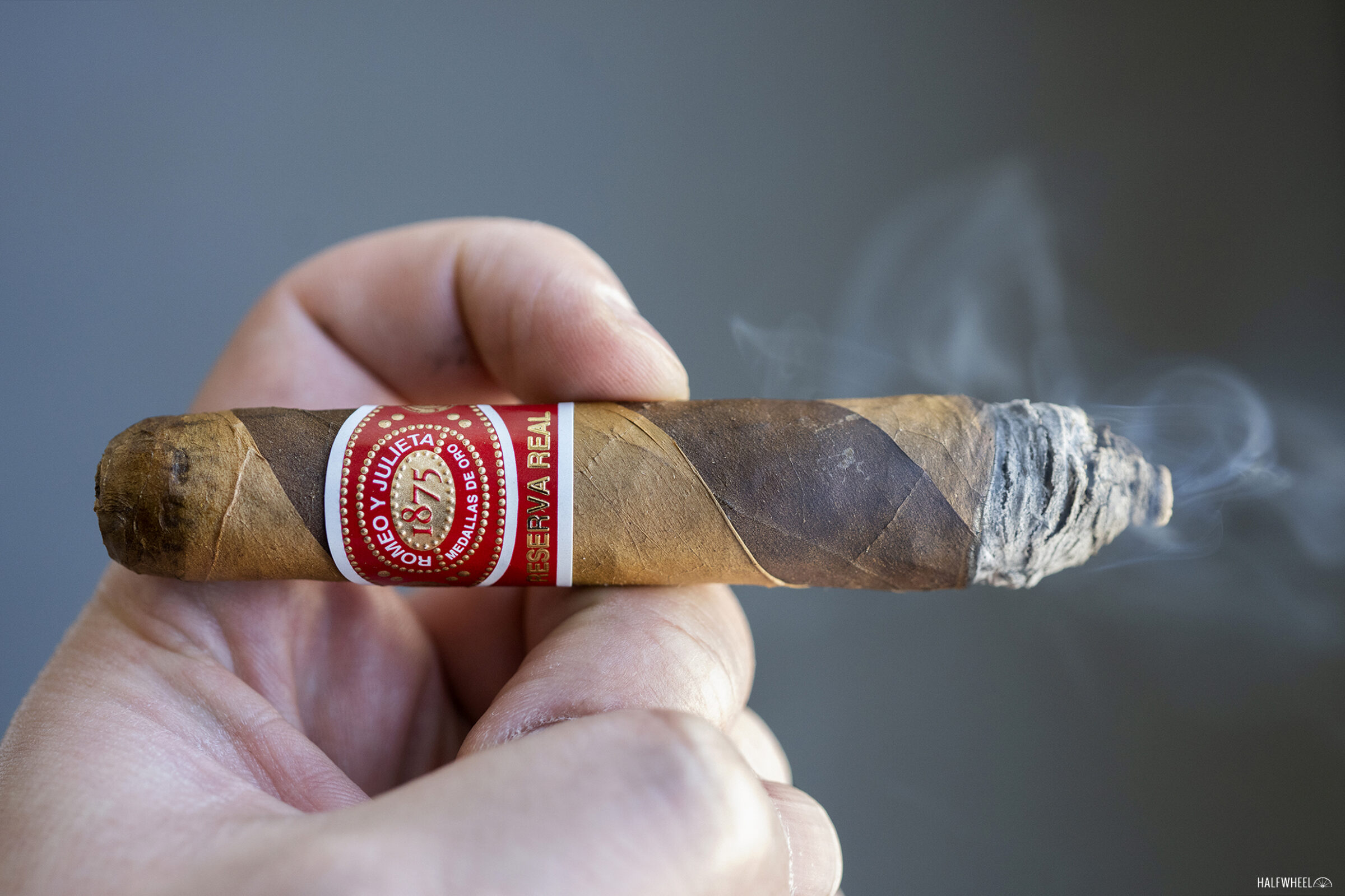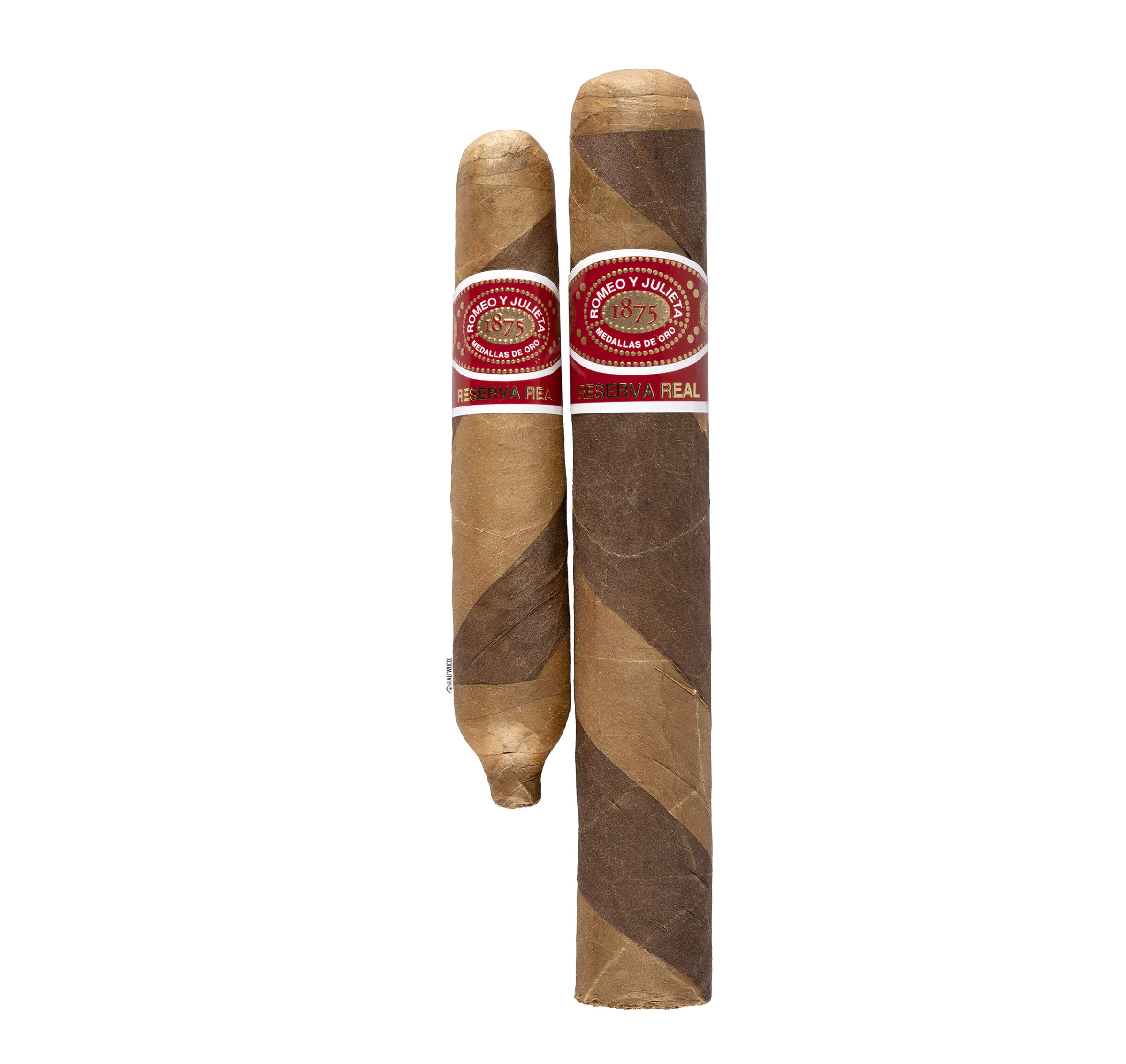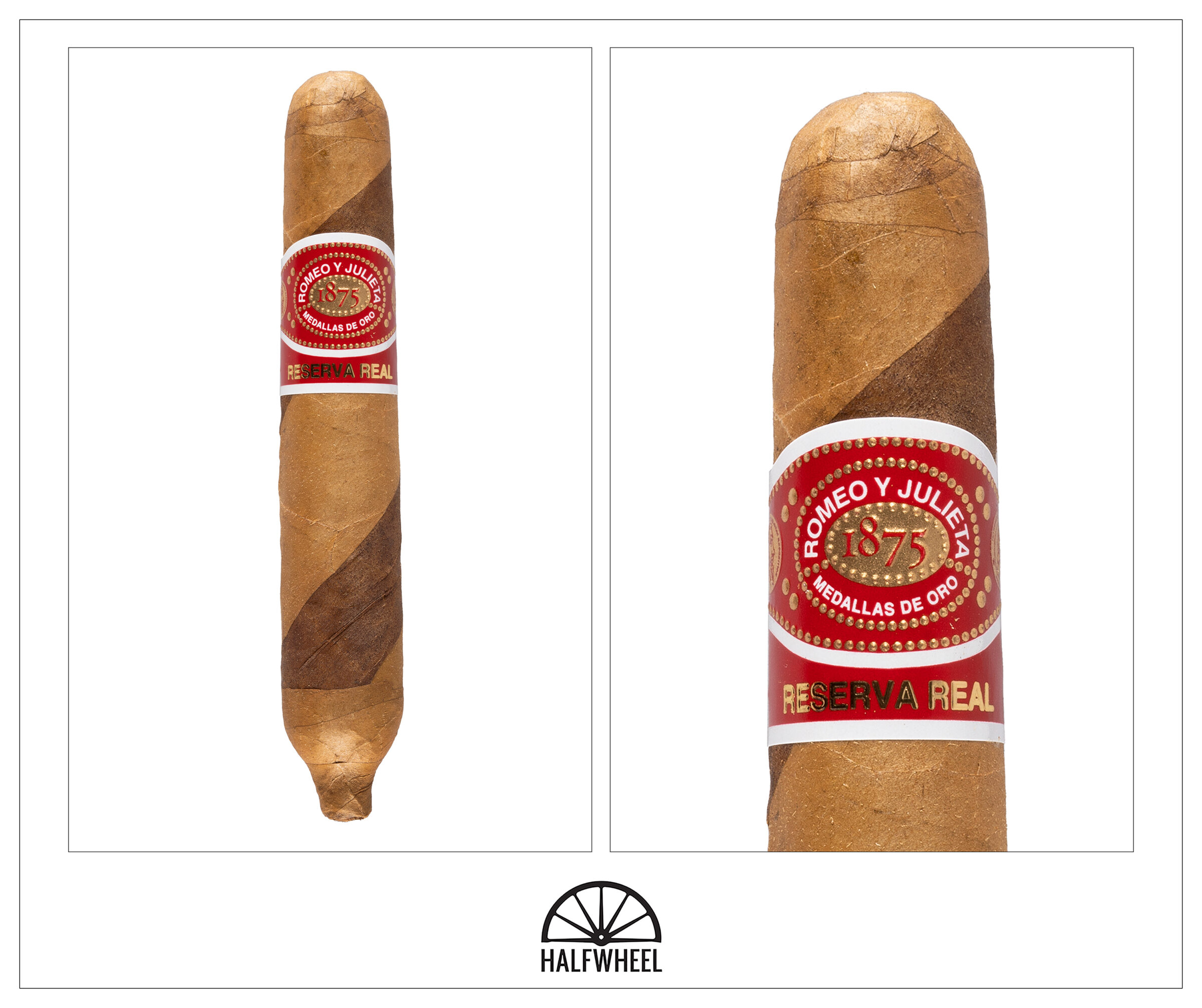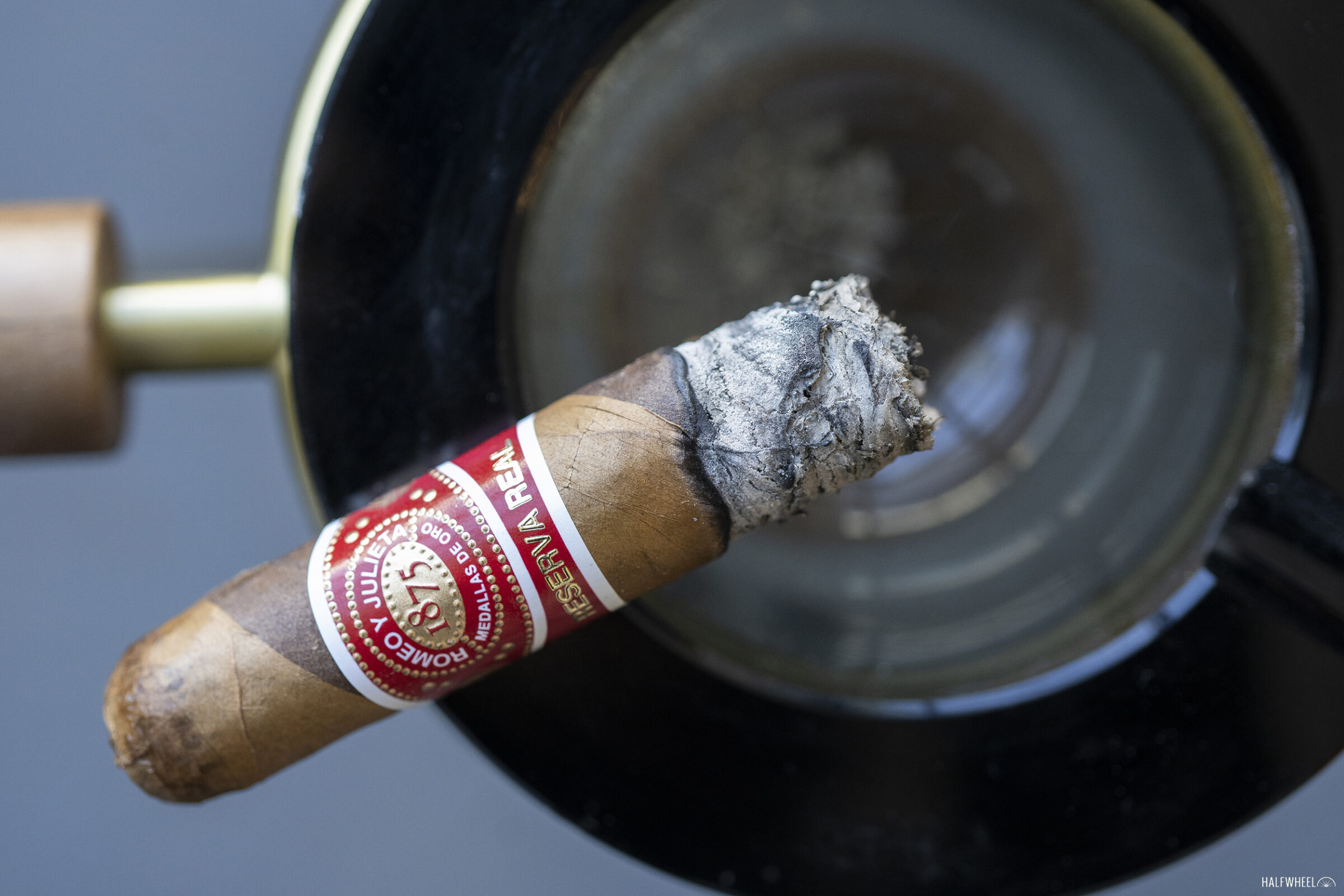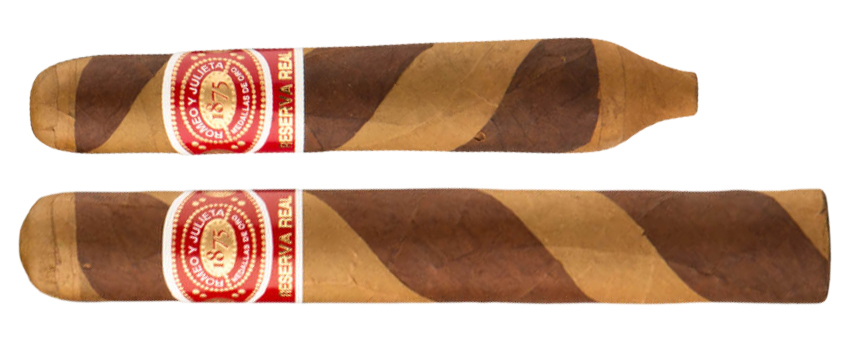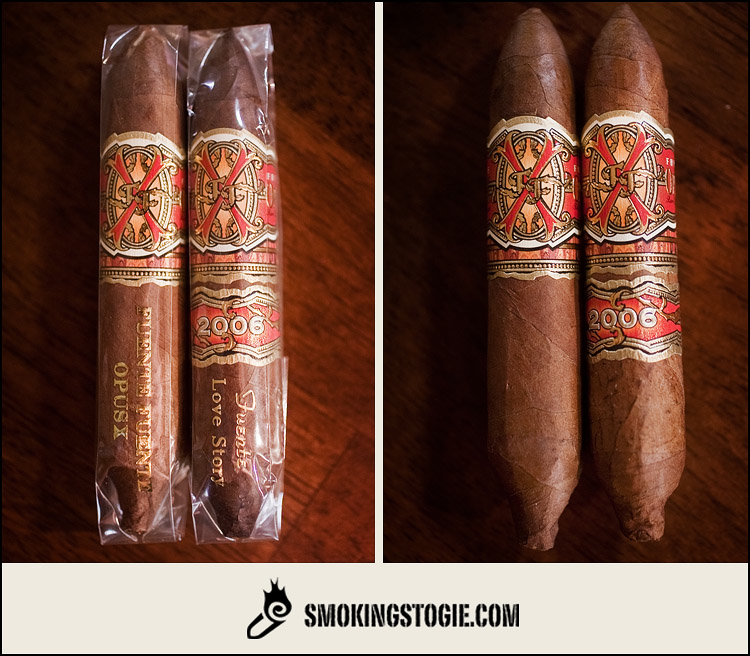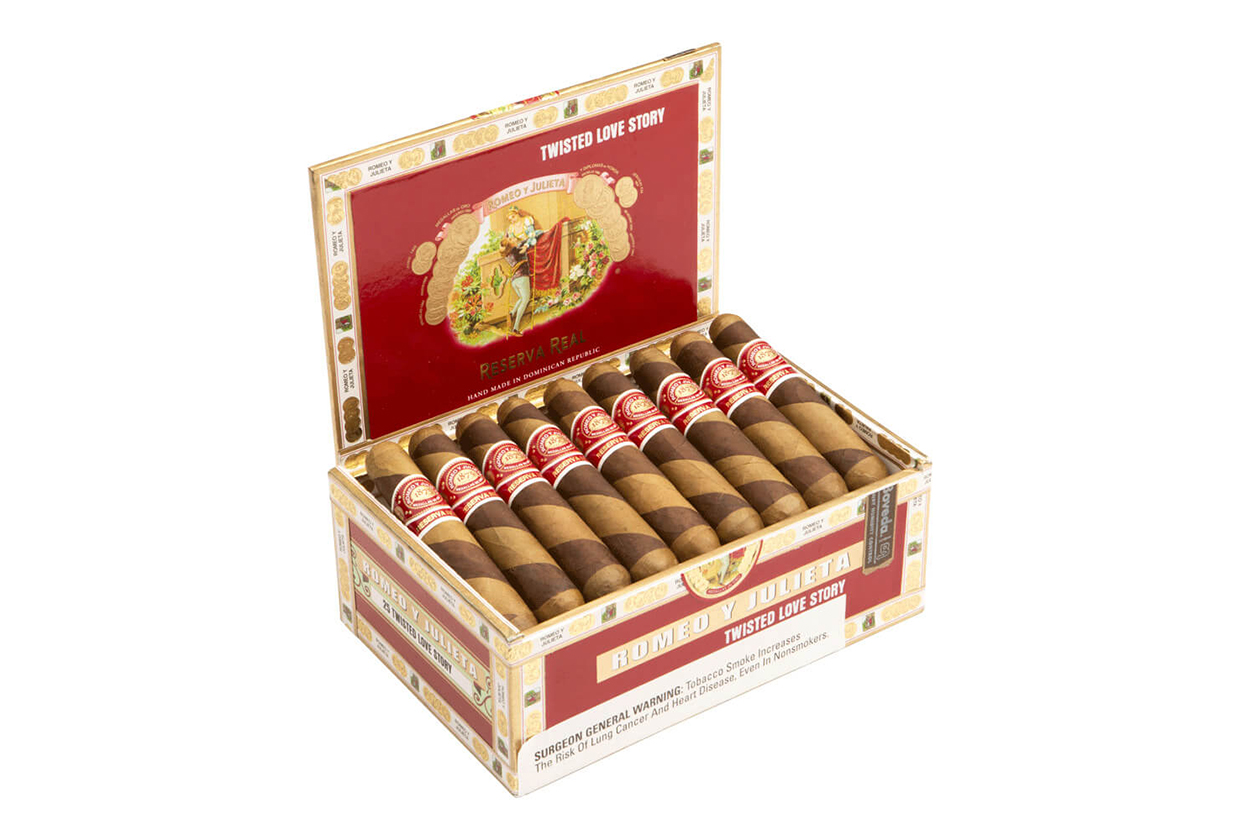I remember when I first saw the announcement about Altadis U.S.A.’s Romeo y Julieta Reserva Real Twisted. And I remember thinking something along the lines of, “I guess they’re going for it.”
In this case, “it” refers to Arturo Fuente’s Hemingway Between the Lines, a limited production barber pole cigar within the Arturo Fuente Hemingway series. Unlike some, I don’t think Arturo Fuente should have the exclusive rights to make a short perfecto with a barber pole wrapper design. But if you are going to make a cigar like this—and then put a red band on it—then you are going to have deal with the comparisons, both positive and negative.
Last year, Atladis U.S.A., which sells the non-Cuban Romeo y Julieta brand in the U.S., announced Reserva Real Twisted, two new barber pole cigars. Each cigar uses a barber pole design on the exterior, a process by which two wrappers are rolled together at a slight angle to produce an alternating design that looks like the stripes of a barber’s pole. Those two wrappers are from Ecuador, one a Connecticut-seed shade grown and the other a habano. Underneath is a Nicaraguan binder over filler tobaccos from the Dominican Republic and Nicaragua.
- Romeo y Julieta Reserva Real Twisted Love Story (4 1/4 x 46) — $8 (Box of 25, $200)
- Romeo y Julieta Reserva Real Twisted Toro (6 x 54) — $9 (Box of 25, $225)
And for those curious, here’s the comparison of the Real Twisted Love Story and the Arturo Fuente Hemingway Between the Lines.
- Cigar Reviewed: Romeo y Julieta Reserva Real Twisted Love Story
- Country of Origin: Dominican Republic
- Factory: Tabacalera de García
- Wrapper: Ecuador (Connecticut-seed & Habano)
- Binder: Nicaragua
- Filler: Dominican Republic & Nicaragua
- Length: 4 1/4 Inches
- Ring Gauge: 46
- Vitola: Perfecto
- MSRP: $8 (Box of 25, $200)
- Release Date: August 2022
- Number of Cigars Released: Regular Production
- Number of Cigars Smoked For Review: 3
If you are wondering why the barber pole design doesn’t extend to the foot or cap of the cigar, it has to do with how cigars are typically rolled. In order to create the barber pole design, most factories will instruct the roller to use two wrappers, spaced apart, meaning that they alternate which wrapper is shown, though both wrappers are present on the cylinder that is the cigar. Furthermore, the cap on the cigar is typically multiple small pieces of tobacco that are put on after the rest of the wrapper. Similarly, a perfecto’s foot typically receives smaller cuts of tobacco to make for a better appearance. In this case, the lighter Connecticut shade wrapper has a somewhat dull appearance and lots of veins, whereas the habano wrapper seems a bit cleaner. The aroma from the wrapper varies between medium-plus to medium-full. Acidity is the standout scent, though dry pasta overtakes it on one of the cigars. The foot is too small for me to really pick up anything without sticking into my nose, something I’m unwilling to do, but I do get some nuttiness from one cigar. Cold draws have sweet cereal over cocoa, grains and some metallic flavors. On one of the cigars, the flavors combine to remind me of the components of a typical milk stout. The draws’ resistances vary between tight and loose.
The first puffs of each cigar remind me of many other Romeo y Julietas that have come from Tabacalera de García over the years, as cedar and cereal—both accented by some mild sweetness—lead the profile before a specific woodiness overtakes them. It finishes with oak, dry crackers and a touch of harshness; each cigar starts at medium-full. Those flavors—particularly that one-two punch of semi-sweet cereal, cedar and this even more specific cedar flavor—remain for the first third. A metallic flavor emerges, which changes the overall profile, and secondary notes include raisins, dry crackers, earthiness and some burn sensations. There’s more of a bite on the finish, seemingly due to an uptick in dryness and metallic flavors. Earthiness is the strongest flavor, followed by crackers, crisp toastiness and black pepper. I’m not fond of the metallic and dry flavors, but retrohaling seems to help flush those sensations out. In their places, oatmeal cookie flavors lead some mild floral flavors until Italian bread crumbs, dry creaminess, starchiness and nuttiness emerge on the finish. Flavor is medium-full, body is medium and strength is medium. Construction-wise, one cigar needs repetitive touch-ups, though the other two are burning just fine.
After the burn line clears the thickest point—also the point in which the habano wrapper is visible—the Romeo y Julieta Reserva Real Twisted Love Story takes a turn for the worse. The metallic flavor, which had been present but in the distance during the first third, is now an ever-present secondary flavor that is joined by some added harshness. Damp wood flavors are the strongest sensation, followed by earthiness, straw and the aforementioned harshness and metallic flavors. Further in the distance are herbal flavors, stale bottled water, leather and remnants of a barnyard. The semi-sweet woodiness and coral flavors that were present on every puff during the first half hour are nowhere to be found. Sharper pepper introduces itself during the finish, followed by acorns and various earth sensations. Retrohales still provide some help, but it’s not like the first third. Leather and a dryness that I can’t quite place lead simple syrup, earthiness and metallic flavors. While the sugar sweetness gives my palate a bit of a reprieve, the harsh flavors eventually come back in and overwhelm the sweetness. Flavor is closer to full, body is medium-plus and strength is medium. Two cigars continue to have no construction issues, though the one cigar that required regular touch-ups in the first continues to need assistance from my lighter.
While I’m not enthralled with the flavor profile during the final third, I am happy that it doesn’t get any worse. In some ways, the Twisted Love Story’s final third is better than the middle portion, though both are far cries from the opening inch of the cigar. Earthiness, fall leaves and leather lead the profile, with white pepper, cinnamon, damp earthiness and sharp toastiness as secondary flavors. Unfortunately, both the harshness and metallic sensations continue to be present on nearly every puff. The finish seems to flatten the profile out even more, allowing the bitterness to become even more prominent. At its peak, creaminess is the strongest flavor followed by hay, though neither last as long time-wise as the metallicness and harshness. I do find a respite of sweetness during two cigars, but it’s not strong enough to have much of an impact. Retrohales are drier with a macadamia nut flavor leading black pepper and saltiness. Throughout the cigar, tiny amounts of fruitiness are present in the retrohales, but it never gets strong enough to make a difference. During one cigar, I find a very distinct pencil lead-like sensation. The retrohales finish like the second third: sharper and drier, which allows the saltiness and metallic flavors to be even stronger. Flavor is medium-full, body is medium and strength is medium. Construction is consistent: two cigars manage to make it start to finish with no construction issues, while one cigar requires regular touch-ups.
Final Notes
- This is a rare instance of halfwheel reviewing a cigar more than a year after it came out. It would seem this size is selling at a quicker rate than Altadis U.S.A. can make them and it took us a while to get the cigars after we ordered them on backorder.
- Barber pole cigars also clearly show that cigars can be rolled in different orientations. As shown above, the stripes of the cigar are in different directions. This is because a single leaf of the plan is cut in half to remove the center vein. Doing so creates a left side and a right side of the leaf. This happens with every cigar, it’s just not something that is all that obvious.
- There was a noticeable change once the cigar began to taper down. I suspect this has more to do with the ring gauge than it does the habano wrapper, though I suppose the latter could be responsible for the change. Whatever the case, the cigar became a lot harsher and the metallic sensation is given much more room to show itself.
- If there was a way to make the second and final thirds taste like the first third, this would be a good cigar.
- I find that many perfecto cigars tend to burn through the foot section very quickly. As someone that enjoys feeling and tasting the cigar change as the taper happens, I appreciated that this cigar did not do that. Here’s a picture that was taken a couple of minutes after the first puff.
- Going full circle on “who’s copying who,” there was an Arturo Fuente cigar called “Love Story,” though it is not a baberpole. In 2006, Arturo Fuente produced an OpusX in a 4 1/2 x 55 perfecto size to celebrate the 55th wedding anniversary of Carlos Sr. and Anna Fuente. Because Altadis U.S.A. was using the “Love Story” name for the Romeo y Julieta Reserve, Fuente changed the name to “Love Affair.” There were very few of these OpusX Love Story-branded cigars released, you can read more about it here.
- The Twisted Love Story was one of two examples in 2022 of another cigar company introducing a cigar that seemed to be going after Arturo Fuente’s popular Hemingway line. La Galera released the Imperial Jade Chiquito Perfecto, which seemed to be going after the Hemingway Short Story. While I understand the frustration that people might have when they think a competitor is knocking off one of their products, I think the cigar industry is probably overly sensitive about these things. Looking at other industries—tech, cars, fashion, alcohol—when one company has success with a product, competitors are generally very quick to pounce.
- As Pete Johnson of Tatuaje once said, “As much people try to ignore Cuba in this business, they are the wheel. And for me there’s no sense trying to recreate the wheel, I just want to copy better than everybody else.”
- JR Cigar, a sister company to Altadis U.S.A., advertises on halfwheel.
- Cigars for this review were purchased by halfwheel.
- Final smoking time was one hour and 20 minutes on average.
- Site sponsors Atlantic Cigar Co., Cigars Direct and Famous Smoke Shop carry the Romeo y Julieta Reserva Real Twisted Love Story. Corona Cigar Co. lists the Toro but not the Love Story.
If you are hoping that the Romeo y Julieta Reserva Real Twisted Love Story tastes like Fuente’s Between the Lines, I probably didn’t need to review the cigar to halt your wishes. These cigars don’t use the same blend, don’t come from the factory, etc. Unfortunately, the Twisted Love Story has larger issues: harshness and metallic flavors after the first inch or so. This falls into a category of cigars that I’d rather look at than smoke; and in that regard, it’s more like Arturo Fuente’s OpusX BBMF than it is a Between the Lines.

